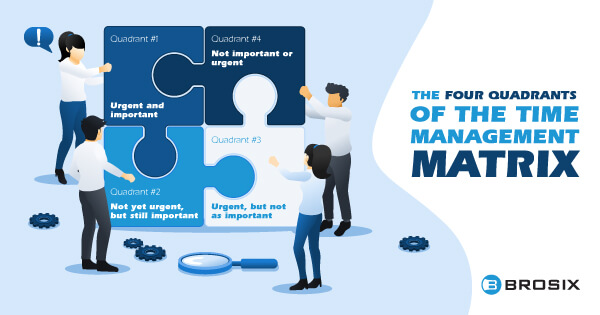Few things are more important to a productive team than ensuring that everyone in your workforce can manage their schedules effectively.
Time management is frequently overlooked as a business skill, but it’s often one of the core factors that determines whether a business is successful. When teams can manage their time efficiently, they don’t just meet deadlines, they also become more efficient.
In today’s digitally enhanced landscape, companies leverage a range of tools to assist employees with time management, from productivity apps, to task tracking tools. However, if you really want to transform your team’s workflows, it might be beneficial to start with a different framework for how projects are assigned and prioritized.
The time management matrix is a phenomenal and easy-to-use tool, enabling every employee to thrive in the business landscape. Here’s everything you need to know about the priority matrix for time management.
What is a Time Management Matrix?
A time management matrix is a flexible tool for managing productivity. The strategy comes in a range of different forms, from the 7 habits time management matrix, to the Eisenhower time management matrix, Covey matrix and the priority time management matrix.
The solution leveraged by most businesses is the Covey time management matrix, which revolves around identifying which tasks in the business have the highest level of urgency or importance. Using this tool, companies determine which tasks need to be addressed as quickly as possible by team members to drive the most value for the company.
Rather than just focusing on what’s important, you determine which tasks are both important and urgent, to align your teams around shared, collaborative goals. When you know what the most important and urgent tasks are in your company, you can begin to create workflows for your team, often assigning tasks to different categories based on their value.
Why is a Time Management Matrix Important?

Managing time effectively is crucial for just about everyone. Whether you’re leading a team, or working on personal goals, managing your time correctly will ensure that you can achieve the best results. A time management matrix essentially gives you the tools you need to prioritize your workflow, determining which tasks need to be completed first, with the highest degree of urgency.
In the business landscape, a priority matrix for time management can also ensure you’re getting the most out of your human resources or teams. According to some studies, the average office worker is only productive for around 2 hours and 53 minutes each day. This means your teams could be wasting a significant amount of time just trying to figure out what they should be doing.
The author of “The 7 Habits of Highly Effective People”, Stephen Covey, suggests that using a time management matrix helps individuals to improve their productivity and focus when working or studying. The right matrix also reduces the risk of team members having to rush to meet deadlines.
The Four Quadrants of the Time Management Matrix

The Covey time management matrix breaks tasks down into four distinctive quadrants, based on their urgency and importance. Each quadrant helps professionals to determine how they use their time to address different tasks and requirements. The quadrants include:
- Quadrant 1: Urgent and important
- Quadrant 2: Not yet urgent, but still important
- Quadrant 3: Urgent, but not as important
- Quadrant 4: Not important or urgent
Let’s take a closer look at each quadrant.
Quadrant 1: Important and urgent
The first quadrant is reserved for tasks that have the highest degree of both urgency and importance. Crucially, just because a task is essential for a business, doesn’t necessarily mean that it’s also urgent. However, if a task requires immediate focus, and is also crucial to the business, it’s something everyone should be working on immediately.
The important thing to remember here is that although many tasks in a business can seem urgent or important, they won’t all be essential to the continued success of the company. Knowing how to define urgency and importance realistically is crucial.
Quadrant 2: Important, but not yet urgent
Quadrant 2 in the time management matrix is reserved for tasks that are crucial, but potentially not yet urgent. For instance, you may need to install an instant messaging tool into your business, but unless your teams are struggling to communicate elsewhere, this task may not be urgent straight away.
Important tasks without urgency are what team members need to focus on after all of the crucial and urgent tasks have been completed. They may not have a specific deadline straight away, but they do hold value for the business.
Quadrant 3: Urgent, but not yet important
Tasks defined as urgent, but not important fall into the third quadrant of the time management matrix. There are specific deadlines associated with these tasks, but they don’t deliver as much value to the business immediately. For instance, team leaders may need to quickly hold a meeting to keep teams informed of events in the business, but this task may not be defined as important.
Experts recommend spending as little time as possible in this quadrant, because it can often be filled with counterproductive tasks which don’t contribute much to business or professional goals.
Quadrant 4: Not urgent or important
Finally, the fourth quadrant is intended for tasks which you have defined as being both unimportant, and not particularly urgent. Tasks like responding to emails, for instance, may have some value, but they shouldn’t be taking up the majority of your day.
Defining which tasks aren’t as important as they seem can help business leaders to avoid allowing their teams to focus too much of their effort on non-productive jobs.
How to Create a Time Management Matrix

A time management matrix can be a valuable tool for both remote and in-office workers alike. It can even help people to accomplish their goals in areas outside of work. The good news is that it’s relatively simple to create your own time management matrix.
All you need to do is start with a simple structure of four boxes, titled with each of the four quadrants mentioned above. Once you have this template:
- List your tasks: Create a to-do list of tasks that need to be completed. At this stage, you simply write down everything that needs to be done, regardless of its value, importance and level of urgency.
- Add deadlines: Next to the tasks on your list, write deadlines or specific dates when the task needs to be completed. This will help you to determine how urgent each project is, and where you need to focus your attention first. Highlight the most urgent tasks on your list.
- Organize by importance: Once you’ve identified the most urgent tasks with the use of deadlines, determine how important they are. Figure out how much value each task will bring to you or your company. Align importance and urgency to pinpoint which tasks need to be completed as quickly as possible.
- Arrange your tasks: Using your matrix, organize your tasks into the correct quadrant based on their urgency and importance. Take note of any tasks which appear to be neither important nor urgent, as these could be draining your valuable time.
- Assess your productivity: Repeat the process for your daily, weekly, and monthly activities, then reflect on your performance. Determine whether using the matrix to organize your tasks has helped you to reduce your stress levels, improve your workflow and boost efficiency.
Using a Time Management Matrix to Your Advantage

Leveraging a time management matrix effectively can help you and your team to become more productive and efficient. It will help you to prioritize your tasks, and ensure you’re focusing on the most valuable and urgent projects on your list first. It’s also a great way to pinpoint any time-consuming tasks which might be damaging your company’s performance.
Using a time management matrix correctly can ensure you and your team members are able to thrive effectively in your workplace, and minimize procrastination.
Once you have your time management matrix, make sure you communicate it clearly and effectively to your team. Share your goals and targets with staff through an instant messaging app like Brosix, or use the in-built whiteboarding capabilities to work on your matrix collaboratively.






